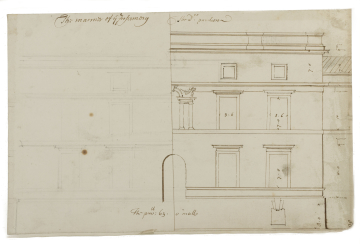
Browse
Reference number
Purpose
Aspect
Scale
Inscribed
Signed and dated
- Undated, but datable c.1727-28
Medium and dimensions
Hand
Watermark
Notes
While the windows of the infirmary at raised ground-floor level correspond with those of the doctors' pavilion, those above this floor are set lower. The difference in height between the tops of the two pavilions, left and right of the centre line, is nearly 5 feet, giving the doctors' pavilion grander proportions than those of the central Infirmary range.
The design is a precursor of the version at the National Maritime Museum, which is shown in a block plan of the hospital dated 1728 and in a larger-scale plan of the infirmary itself (ART/1/7 and 56; Wren Society, VI, pls 45 and 49). Both are inscribed with dimensions by Hawksmoor. Hawksmoor's inscribed width on the Soane Museum elevation 63 feet. In the larger-scaled infirmary plan, ART/1/56, the matching end-pavilions of the infirmary are 65 feet wide wide. They have central doors, but three rather than two windows on each side. The central door in the plan gives access to a corridor that runs around the entire three-block range, connecting the doctors' pavilions with the rear infirmary range (see also [11/12]).
The dating of the design to c.1728 places it within the Surveyorship of Colen Campbell (1726-29). The use of Palladian-revival motifs such as the central Venetian window and the simple classical window cornices may reflect his influence.
Literature
Level
Sir John Soane's collection includes some 30,000 architectural, design and topographical drawings which is a very important resource for scholars worldwide. His was the first architect’s collection to attempt to preserve the best in design for the architectural profession in the future, and it did so by assembling as exemplars surviving drawings by great Renaissance masters and by the leading architects in Britain in the 17th and 18th centuries and his near contemporaries such as Sir William Chambers, Robert Adam and George Dance the Younger. These drawings sit side by side with 9,000 drawings in Soane’s own hand or those of the pupils in his office, covering his early work as a student, his time in Italy and the drawings produced in the course of his architectural practice from 1780 until the 1830s.
Browse (via the vertical menu to the left) and search results for Drawings include a mixture of Concise catalogue records – drawn from an outline list of the collection – and fuller records where drawings have been catalogued in more detail (an ongoing process).

